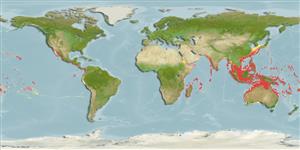Common names from other countries
Environment: milieu / climate zone / depth range / distribution range
Ekologi
Berasosiasi dengan karang; kisaran kedalaman 6 - 145 m (Ref. 96667). Tropical
Indo-Pacific.
Length at first maturity / Size / Weight / umur
Maturity: Lm ? range ? - ? cm Max length : 38.5 cm TL jantan/; (Ref. 3145)
Raptorial claw, 4 cm long. Banded with alternate light and dark bands.
Collected with spears, snares and bait, or at night with light nets (Ref. 92). Burrows in level bottoms near shore (Refs. 92, 80410); and swims at night (Ref. 80410). Intertidal to subtidal (Ref. 106854).
Life cycle and mating behavior
Kematangan | Reproduksi, perkembang biakan | Pemijahan | telur-telur | Fecundity | Larva
Some members of the order Stomatopoda pair for life and some come together only to mate. Males produce sperm ducts rather than spermatophores; females can brood a maximum of 50,000 eggs. Life cycle: Eggs hatch to a planktonic zoea which lasts for 3 months.
rujukan utama
Acuan | Koordinator | mitra
Manning, R.B. 1998. (Ref. 92)
Status IUCN Red List (Ref. 130435)
status CITES (Ref. 108899)
Not Evaluated
Not Evaluated
ancaman kepada manusia
Harmless
penggunaan manusia
| FishSource |
Alat, peralatan
informasi lanjut
Umur / SaizPertumbuhanpanjang-beratpanjang-panjangMorfologiLarvaKelimpahan
Sumber internet
Estimates based on models
Preferred temperature
(Ref.
115969): 22.6 - 29, mean 27.9 (based on 2362 cells).
keancaman
Low to moderate vulnerability (29 of 100).
kategori harga
Unknown.
